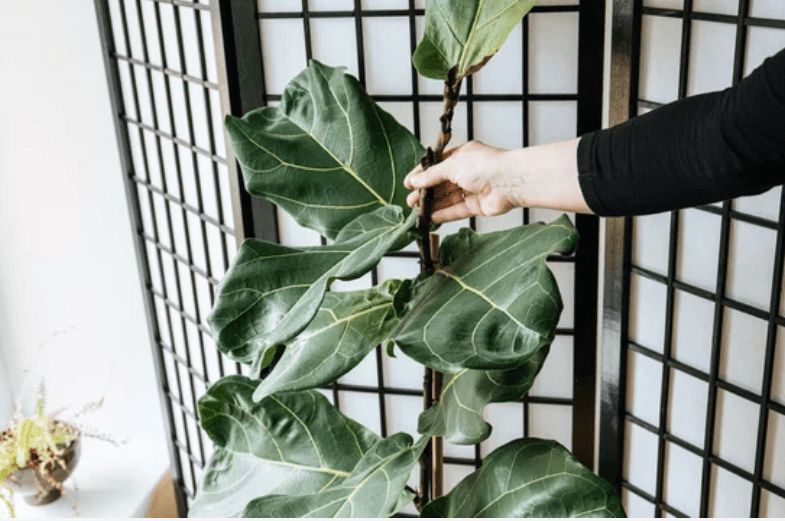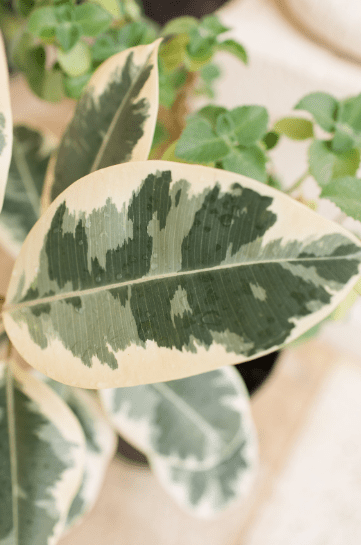
What is Ficus Shivereana?
Ficus Shivereana, or Variegated Ficus, is a popular houseplant with unique foliage. It features large, oval-shaped leaves with variegated patterns of cream and green. This easy-care plant thrives in bright, indirect light and requires moderate watering to maintain its beauty.
Ficus Shivereana, a member of the Moraceae family, stands out as an illustrious addition to indoor horticultural collections. Its distinct variegation patterns and captivating growth habits, especially for ficus plants, can be a joy to observe, but it demands meticulous care to flourish.
Drawing from professional horticultural insights, we’ll delve into the intricacies of shipping and cultivating Ficus Shivereana in a new environment, ensuring proper care to make it a radiant specimen in your plant ensemble.
The phenology of Ficus Shivereana, a rare houseplant, is crucial to understand. Understanding the phenological stages of Ficus Shivereana – the recurring plant lifecycle events influenced by environmental cues such as temperature, humidity, and photoperiod – is paramount for determining the optimal growing season, especially if the plant is placed near a south-facing window.
By aligning care practices with these growth phases, we can ensure the plant receives enough nutrients to foster vibrant foliage and bolster resilience.
Taxonomy and Varieties The Ficus Shivereana Moonshine has garnered admiration for its silvery-green leaf patterns. Due to its striking hue, this cultivar is best positioned in a space where its elegance can be genuinely appreciated.
However, the Shivereana species boasts other intriguing cultivars worth exploring:
Ficus Shivereana Variegata
Ficus Shivereana Variegata, or Ficus altissima, is an ornamental fig tree with variegated leaves with green and white patterns. It is native to tropical regions of Africa and Asia and can grow up to 10 feet tall indoors with the help of potting soil that contains vermiculite.
This plant requires bright indirect light, such as bright sunlight, moderate watering, and well-draining soil. It is also sensitive to temperature changes and drafts, so it should be kept away from windows and air vents.
Ficus Shivereana Variegata is a beautiful and easy-to-care-for houseplant that can add a touch of nature to any space.
Ficus Shivereana Variegata
Ficus Shivereana Variegata is an ornamental fig tree with variegated leaves with green and white patterns. It is native to tropical regions of Africa and Asia and can grow up to 10 feet tall indoors.
This plant requires bright indirect light, moderate watering, and well-draining soil. It is also sensitive to temperature changes and drafts, so it should be kept away from windows and air vents.
Ficus Shivereana Variegata is a beautiful and easy-to-care-for houseplant that can add a touch of nature to any space.

Ficus Shivereana Ruby
Ficus Shivereana Ruby, also known as the variegated rubber plant or the red emerald ficus, is a beautiful plant with leaves that are variegated with shades of green, cream, and pink. One of its most striking features is its unique pattern of white and pink veins that run through the leaves.
This plant is a cultivar of the Ficus elastica ’Shivereana.’ It is a popular choice for indoor gardening due to its ability to thrive in proper conditions, including indirect bright light, low maintenance, and stunning appearance.
Ficus Shivereana Ruby is also known as the variegated rubber plant or the red emerald ficus.

Horticultural Practices for Beginners
- Substrate Composition: Prioritize a well-draining substrate, blending peat moss, perlite, sand, and organic matter to ensure roots have optimal gas exchange and moisture levels. This mitigates issues like anoxia and root rot.
- Irrigation Protocol: Avoid a fixed watering regimen; assess substrate moisture, ensuring the upper inch dries out before subsequent watering. This mimics the plant’s natural habitat conditions and promotes root vigor.
- Photoperiod and Thermal Needs: These plants thrive under indirect luminance, reminiscent of the filtered sunlight of their natural understory habitat. Thermally, aim for a stable range between 60-75°F (15-24°C).
- Propagation: Vegetative propagation via stem cuttings is preferable. Ensure nodes are submerged for water propagation or in contact with a moisture-retentive medium for soil propagation.
- Nutrition: Opt for a well-balanced, slow-release fertilizer rich in macronutrients and trace elements. Always adhere to the label rate to avoid salt accumulation and root burn.
Pest Management and Plant Health
Regular scouting is vital to detect early infestations of common pests such as mealybugs, spider mites, or aphids, as well as leaf spot disease. Implement Integrated Pest Management (IPM) strategies, starting with non-chemical methods like neem oil or insecticidal soap before considering synthetic insecticides. By following steps like these, you can effectively manage pest infestations and prevent irreversible plant damage. Another effective non-chemical method is using a humidifier to increase the humidity levels, which can deter pests from infesting plants and prevent irreversible damage.
Diseases like leaf spots and powdery mildew can also be deterred by ensuring good airflow and adequate light, avoiding water stagnation, employing fungicides when needed, and using clean and sharp scissors to prune infected leaves and stems.
Toxicity Advisory
Being part of the Ficus genus, Shivereana possesses latex, which can be an irritant and is toxic if ingested. Ensure it’s out of reach from pets and children and practice good hygiene post-handling. Additionally, it is essential to note that the leaves of your ficus shivereana should not be ingested or handled without proper protection.
Horticultural Troubleshooting
A dropping leaf can be symptomatic of physiological stress – assess light conditions, scrutinize for pest presence, and ensure the plant isn’t root-bound. Periodic repotting into a slightly larger pot with fresh soil can refresh its substrate and give roots room to expand, improving drainage holes.
Concluding Remarks
Cultivating Ficus Shivereana from a horticultural standpoint demands a harmonious blend of science and art. By aligning care practices with its intrinsic growth rhythms, appreciating its taxonomy, and preemptively managing pests and diseases, we can ensure that this botanical marvel flourishes and stands as a testament to the wonders of plant biology.






















